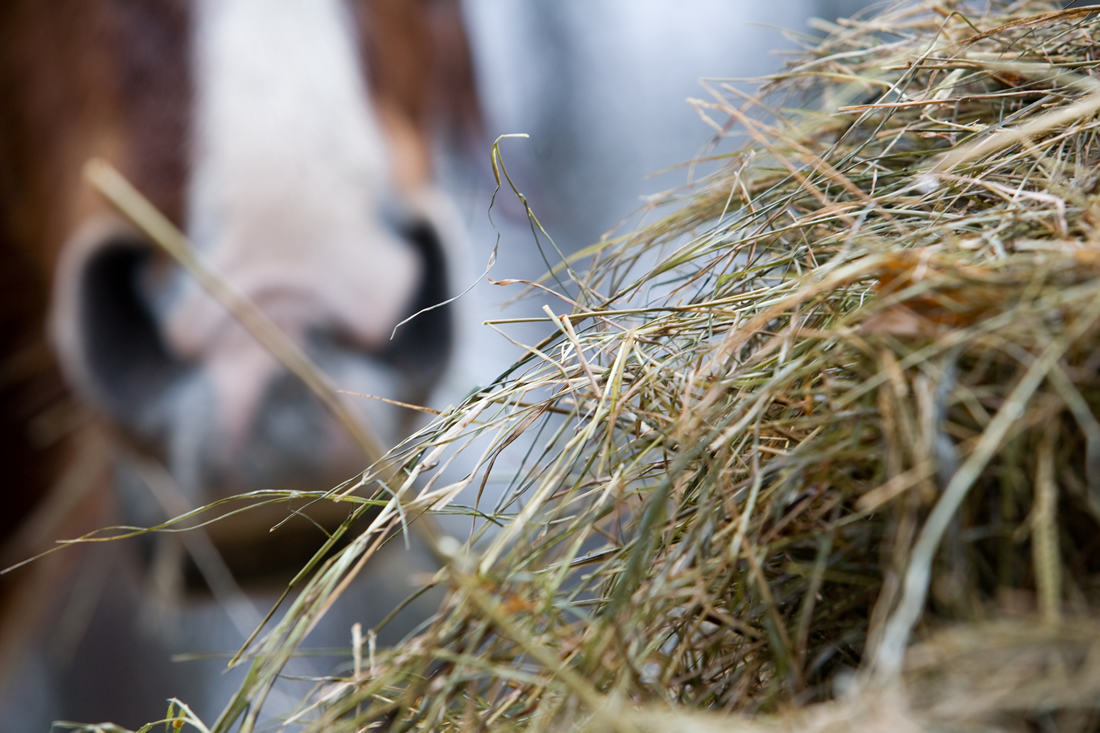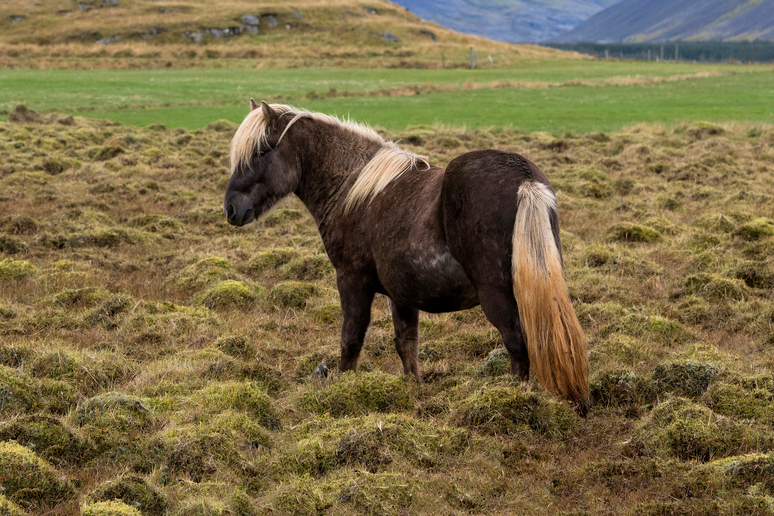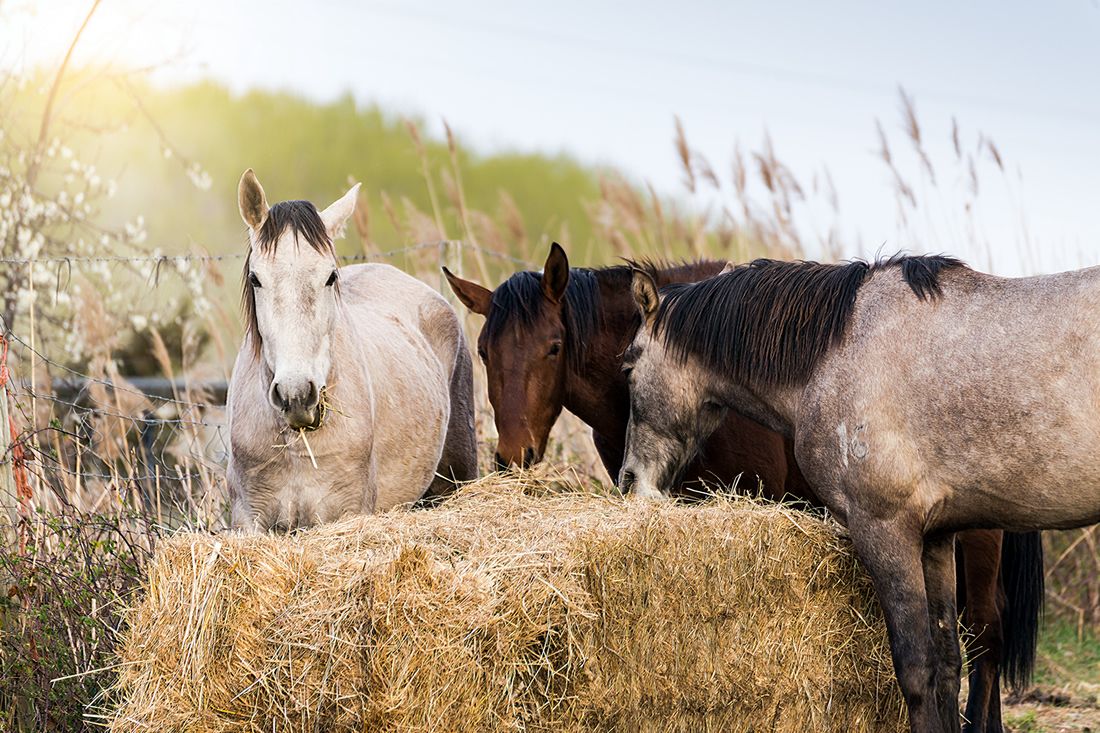Hay dunking describes an abnormal equine feeding behaviour in which horses dunk their hay in water before chewing and swallowing it.
This can be a messy habit and many horse owners want to know why it happens and how to stop it. While there is little research into why horses dunk their hay, several theories attempt to explain the behaviour.
Anecdotal reports suggest some horses dunk their hay before eating it simply because they prefer it when it is dampened or because it helps them chew. [1]
It is also thought that underlying health issues can promote the behaviour, including gastrointestinal discomfort, allergies to dust, and dental issues.
If you are concerned that your horse’s hay dunking habit is a serious issue, consult with your veterinarian to determine if she requires treatment for any health problems.
If your horse simply prefers moistened hay, you may want to consider soaking your forage prior to feeding. Placing one water source near the hay and another one further away can also ensure your horse always has access to clean water.
Strategies to reduce the mess caused by hay dunking include placing a rubber mat in your horse’s feeding area and feeding hay from a hay net.
What is Hay Dunking?
Hay dunking describes the equine behaviour of taking hay into the mouth and subsequently dunking it in a nearby water source before chewing and swallowing it.
Horses that engage in hay dunking typically dip the hay in water located close to their feed. However, some anecdotal reports describe horses dragging their hay to a water source to be able to engage in the behaviour.
Hay dunking is most noticeable when horses are fed in a stall or small area. The prevalence of hay dunking in horses is unknown.

Advantages of Hay Dunking
Hay dunking is not necessarily a negative behaviour. A key physiological benefit of dunking hay in water is increased hydration.
Horses in the wild or on pasture consume large amounts of water as moisture in grass and other plants. In comparison, horses that are domesticated often consume a diet consisting primarily of dry hay.
Dunking hay in water before chewing and swallowing may help to increase water intake, reducing the risk of digestive issues such as choking and impaction colic.
In addition, adding moisture to the hay may make it easier for the horse to chew, swallow, and digest, leading to improved nutrient absorption.
Disadvantages of Hay Dunking
Hay dunking can be a messy habit. If hay is dropped in and left in a horse’s water source for an extended period, it can ferment and accumulate mould or bacteria. [13]
Horses that dunk their hay typically need their water sources cleaned more often, especially in warm temperatures. Water troughs or buckets can turn slimy quickly as microorganisms propagate.
Hay dunking may indicate a medical problem related to gastrointestinal, dental, or respiratory health. Horses that are uncomfortable may dunk their hay to try to feel better.
For some horses, the behaviour is a learned habit and does not indicate any underlying health problem. However, it is important to rule out pain and illness as possible causes of this behaviour before you assume your horse is doing it for no reason.
Causes of Hay Dunking
Although the exact causes of hay dunking are unknown, potential causes for this behaviour may include respiratory irritation, dental issues, gastric ulcers, or behavioural issues.
1) Respiratory Irritation
All horses are obligate nasal breathers, meaning they can only breathe through their nostrils and not their mouths.
Nasal irritation due to exposure to inhaled allergens is a possible reason that horses might dunk their hay in water before eating it. Dunking the hay before eating it reduces the amount of dust that is inhaled. [14]
Horses can be allergic to a wide range of allergens in the barn, hay, or feed. Dust, molds, and bacteria are known to cause allergic reactions in horses. [2][3]
With prolonged exposure to inhaled environmental allergens, some horses develop respiratory illnesses such as heaves, chronic obstructive pulmonary disease, or inflammatory airway disease. [2][3]
Respiratory issues including nasal irritation are particularly prevalent during the summer when the level of allergens increases in the environment.
Signs of respiratory irritation in horses may include coughing, sneezing, and headshaking.
2) Poor Dentition and Oral Pain
Horses require good dentition (healthy teeth) to chew their forage so it can be properly digested in the gastrointestinal tract.
If your horse is suffering from dental issues, hay dunking may add moisture that makes it easier to chew forages. Certain types of hay such as mature grass or alfalfa may contain tougher stems that make it more difficult to chew than soft grass hay.
Your horse may also prefer soft-textured forages if she has a painful sore in her mouth or an injury to her gum line.
Common types of dental problems in horses include fractured and overgrown cheek teeth. [4][5][6] Sharp points and worn enamel ridges on the teeth may also prevent the adequate chewing and grinding of forage.
Gaps (diastemas) can develop between the teeth that promote feed impaction between these spaces. When food lodges in the spaces between teeth it decomposes and promotes inflammation that can lead to periodontal disease.
Signs of dental disease may include weight loss, poor appetite, and hypersalivation.
Quidding is also a common observation in horses with advanced dental disease and describes the action when horses purposefully drop their feed without swallowing it.
3) Ulcers
Rough, dry, and stemmy forage may cause irritation in the gastrointestinal tract, especially if ulcers are present. Horses that suffer from ulcers may dunk each mouthful of hay in their water buckets to soften it before swallowing it to relieve pain and discomfort caused by rough-textured forage.
A significant number of horses are affected by ulcers. [7][8][9][10] Common types of ulcers occurring in horses include stomach ulcers (squamous and glandular) and colonic (hindgut) ulcers.
Intermittent feeding, high-intensity exercise, stress, and the use of certain drugs can promote ulcers.
Horses with ulcers may exhibit signs including weight loss, poor appetite, colic, teeth grinding, poor performance, dull coat, and irritability.
4) Learned Behavior
Some horses engage in hay dunking behaviour even though they don’t have any health problems. It’s possible that hay dunking behaviour initially developed at a time in the horse’s history when she was suffering from a health issue and found that hay dunking helped reduce discomfort.
When horses learn that a certain behaviour enables them to feel better, they may continue it even after the initial cause has resolved. A proper veterinary evaluation is needed to determine what factors (previously existing or new) may be driving hay dunking behaviour.
Should You Consult With a Veterinarian?
The first step to take to investigate why your horse is hay dunking is to consult with a veterinarian.
Although hay dunking may not be due to a medical issue, a veterinary health assessment is needed to determine if an underlying health problem is promoting the behaviour.
Your veterinarian may recommend one of the following treatments:
Gastroscopy and Ulcer Treatment
The only way to accurately diagnose equine gastric ulcers is through gastroscopy. This procedure allows your veterinarian to locate and examine lesions in the lower esophagus, stomach, or upper section of the small intestine.
Treatment of ulcers in horses may require the administration of medication such as omeprazole (the primary ingredient in GastroGard and UlcerGard), sucralfate (Carafate), antacids, and histamine-receptor antagonists such as ranitidine. [7][10]
Other strategies to help heal and prevent ulcers include providing your horse with consistent access to forage, reducing stress, and avoiding a high-grain diet.
If your horse is prone to ulcers, consider feeding Visceral+, a gut health supplement formulated to maintain stomach and hindgut health.
Dental Examination and Treatment
Horses should have a dental examination at least once per year to check the health of their teeth. Most horses require dental floating annually or more often.
During a dental examination, your veterinarian or equine dental specialist will check your horse’s mouth for sharp points on teeth, gaps between teeth, mobile teeth, and signs of dental disease.
Routine floating may improve minor dental conditions. If severe damage has occurred to the teeth and surrounding tissues, extraction may be necessary.
Horses with dental issues that cannot be corrected with veterinary intervention may benefit from a diet containing chopped hay, hay cubes, or hay pellets. These forms of forage are typically easier to chew and digest than long-stem hay.
Soaking these feeds will also soften them to improve a horse’s ability to chew.
Assessing Respiratory Health and Treating Illness
Blood work and chest x-rays can be helpful in identifying some forms of respiratory illness.
Respiratory testing may involve collecting and assessing a sample of fluid from the windpipe. Bronchoalveolar lavage (BAL) is a procedure that is used to collect a sample of fluid from the lungs for testing.
If your horse has chronic respiratory issues, your veterinarian may recommend treatment with medication. Steroids and Beta-2 agonists such as clenbuterol are medications commonly used to treat respiratory conditions.
Horses with respiratory conditions may benefit from being fed spirulina to support their overall health and improve the symptoms of their condition. [11][12]
Management Strategies to Reduce Mess
To help reduce the mess your horse creates due to hay dunking, consider the following:
Regularly Clean Water Buckets & Troughs
Keep a sieve on hand to use for collecting hay out of your horse’s water bucket/trough between cleanings.
Do not leave hay in water sources as it may ferment and become unsafe for your horse to eat.
Provide Two Sources of Water
Provide one source of water for your horse to dunk hay in close to where she eats. Provide an additional water source at a further distance to keep it clean.
Your horse will hopefully use the water nearest the hay for dunking and use the other source for drinking.
Consider Soaking or Steaming Your Hay
Soak or steam your horse’s hay before you feed it. If the hay is already moistened, your horse may be less likely to engage in hay dunking.
Soaking hay for 10 or 30 minutes can significantly reduce the number of inhalable particulates in it. Steaming also reduces inhalable particulates, destroys pathogens, and enhances the palatability and digestibility of hay.
Place a Rubber Mat Where Your Horse Eats
Place a mat in the area where your horse eats to facilitate easier cleaning. You should also keep stall bedding (shavings or other materials) away from any area that your horse is dunking.
Use a Slow Feeder
Consider using a slow feeder or hay net to feed your horse’s hay to limit the amount of hay your horse can grab and dunk at once. This may help to reduce mess.
Summary
- The specific causes of hay dunking have not been researched.
- Anecdotal reports suggest potential causes of hay dunking may be related to gut health, dental issues, or respiratory allergies.
- Horses that engage in hay dunking should be assessed by a veterinarian.
- Not all horses that dunk their hay have a health issue. Hay dunking may be a learned behavior.
References
- Houpt, KA. “Maintenance behaviours.” The domestic horse: the evolution development and management of its behaviour. Cambridge University Press, Cambridge, UK (2005): 94-109.
- Halliwell, RE. et al. The role of allergy in chronic pulmonary disease of horses. J Am Vet Med Assoc. 1979.
- Couetil, L. et al. Equine Asthma: Current Understanding and Future Directions. Front Equine Vet. 2020.
- Rowley, K.J. et al. A computed tomographic study of endodontic and apical changes in 81 equine cheek teeth with sagittal fractures. Equine Vet J. 2022.
- Dixon, P.M. et al. A review of equine dental disorders. Vet J. 2005.
- Nicholls, V.M. et al. Dental Disease in Aged Horses and Its Management. Vet Clin North Am Equine Pract. 2016.
- Buchanan, BR. Et al. Treatment and Prevention of Equine Gastric Ulcer Syndrome. Vet Clin North Am Equine Pract. 2004.
- Sykes, B.W. et al. European College of Equine Internal Medicine Consensus Statement–Equine Gastric Ulcer Syndrome in Adult Horses. J Vet Intern Med. 2015.
- Bell, R.J.W. et al. Equine gastric ulcer syndrome in adult horses: a review. New Zealand veterinary journal. 2007.
- Andrews, F.M. Colonic Ulcers. Louisiana State University Veterinary Medicine. 2022.
- Nemoto-Kawamura et al. Phycocyanin enhances secretary IgA antibody response and suppresses allergic IgE antibody response in mice immunized with antigen-entrapped biodegradable microparticles. J Nutri Sci Vitaminol. 2004.
- Kellon, E. Use of the Herb Gynostemma Pentaphyllum and the Blue-green Algae Spirulina Platensis in Horses. Equine Congress. 2006.
- Glatter, M et al. Feed Intake Parameters of Horses Fed Soaked or Steamed Hay and Hygienic Quality of Hay Stored following Treatment. Animals. 2021.
- Blackman, M. and Moore-Colyer, M.J.S. Hay for horses: the effects of three different wetting treatments on dust and nutrient content. Anim Sci. 2010.














Leave A Comment